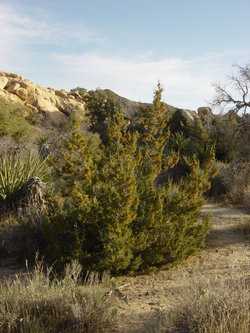Juniperus californica
| Juniperus californica | |
|---|---|
 | |
| In Joshua Tree National Park, California | |
| Conservation status | |
| Scientific classification | |
| Kingdom: | Plantae |
| Division: | Pinophyta |
| Class: | Pinopsida |
| Order: | Pinales |
| Family: | Cupressaceae |
| Subfamily: | Cupressoideae |
| Genus: | Juniperus |
| Species: | J. californica |
| Binomial name | |
| Juniperus californica Carr. | |
 | |
| Natural range of Juniperus californica | |
 | |
Juniperus californica (California Juniper) is a species of juniper native to southwestern North America; as the name implies, it is mainly found in California, although its range also extends through most of Baja California, a short distance into the Great Basin in southern Nevada, and western Arizona. It grows at moderate altitudes of 750 to 1,600 meters (2,460 - 5,200 ft).

It is a shrub or small tree reaching 3 to 8 m (9.8 – 26 ft), but rarely up to 10 m (33 ft) tall. The shoots are fairly thick compared to most junipers, between 1.5 and 2 millimeters (0.059 - 0.079 in.) in diameter. The leaves are arranged in opposite decussate pairs or whorls of three; the adult leaves are scale-like, 1 to 5 mm (0.039 - 0.20 in.) long on lead shoots and 1 to 1.5 mm (0.039 - 0.059 in.) broad. The juvenile leaves (on seedlings only) are needle-like, 5 to 10 mm (0.20 - 0.39 in.) long. The cones are berry-like, 7 to 13 mm (0.28 - 0.51 in.) in diameter, blue-brown with a whitish waxy bloom, and contain a single seed (rarely two or three); they are mature in about 8–9 months. The male cones are 2 to 4 mm (0.079 - 0.16 in.) long, and shed their pollen in early spring. It is largely dioecious, producing cones of only one sex, but around 2% of plants are monoecious, with both sexes on the same plant. The bark is typically thin and appears to be "shredded".[1]
It is closely related to Utah Juniper (J. osteosperma) from further east, which shares the stout shoots and relatively large cones, but differs in that Utah Juniper is largely monoecious, and its cones take longer to mature (two growing seasons); Utah Juniper is also markedly more cold-tolerant.
California Juniper is becoming a popular species for bonsai; it is also valued in dry areas as a garden plant for its heat and drought tolerance. Not considered globally threatened, one of the southernmost populations, on Guadalupe Island off Baja California, was destroyed in the late 19th century by feral goats.[2]
References
Further reading
- Adams, Robert P. (1993): 10. Juniperus californica. In: Flora of North America Editorial Committee (eds.): Flora of North America North of Mexico vol. 2.
- Adams, Robert P. (2004): Junipers of the World: The genus Juniperus. Trafford Publishing ISBN 1-4120-4250-X
- Charters, Michael L. (2007): Wildflowers and Other Plants of Southern California: Juniperus californica. Retrieved 2007-OCT-16.
- Conifer Specialist Group (1998). Juniperus californica. 2006. IUCN Red List of Threatened Species. IUCN 2006. www.iucnredlist.org. Retrieved on 12 May 2006.
- León de la Luz, José Luis; Rebman, Jon P. & Oberbauer, Thomas (2003): On the urgency of conservation on Guadalupe Island, Mexico: is it a lost paradise? Biodiversity and Conservation 12(5): 1073–1082. doi:10.1023/A:1022854211166 (HTML abstract)
External links
| Wikimedia Commons has media related to Juniperus californica. |
